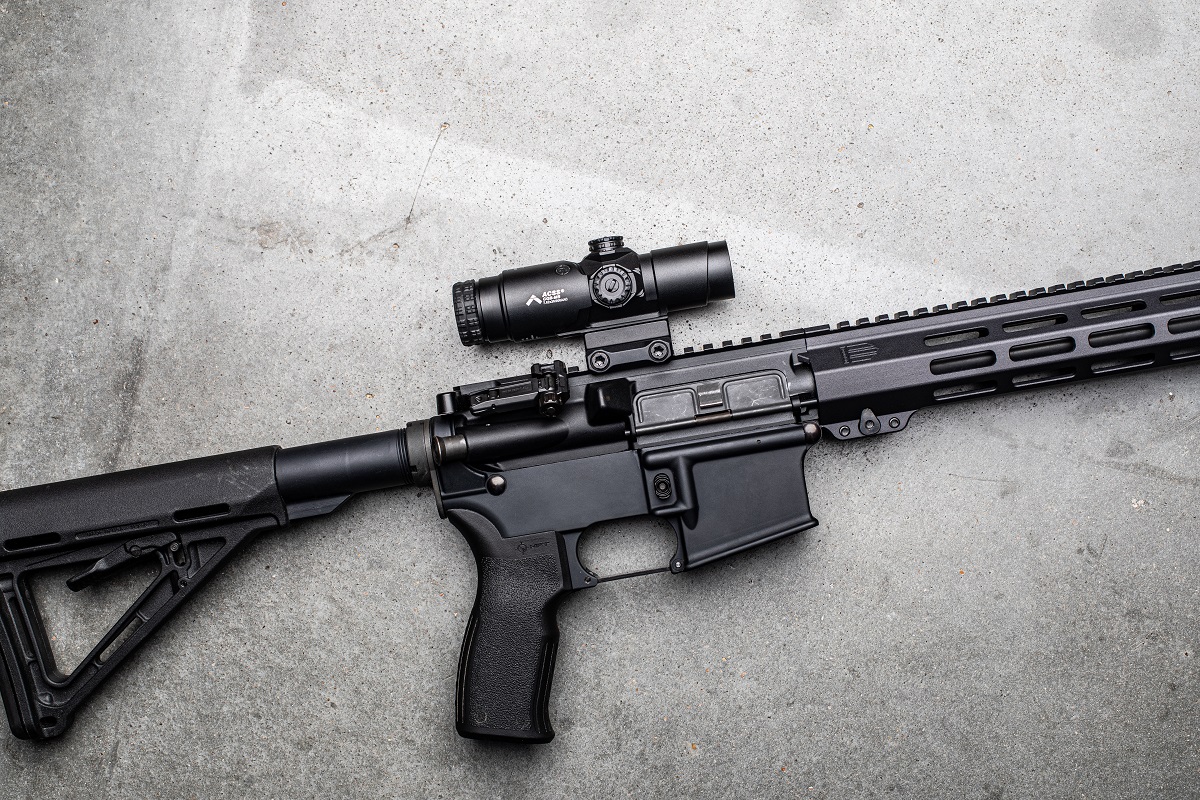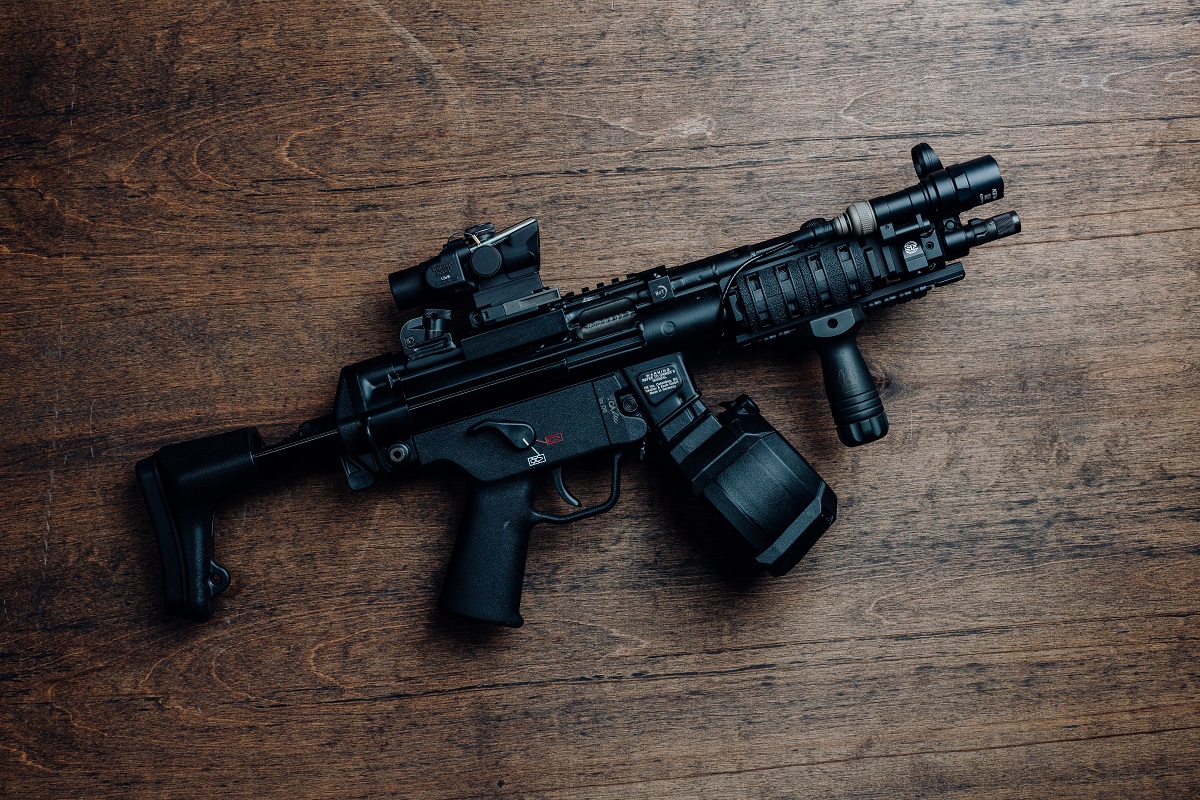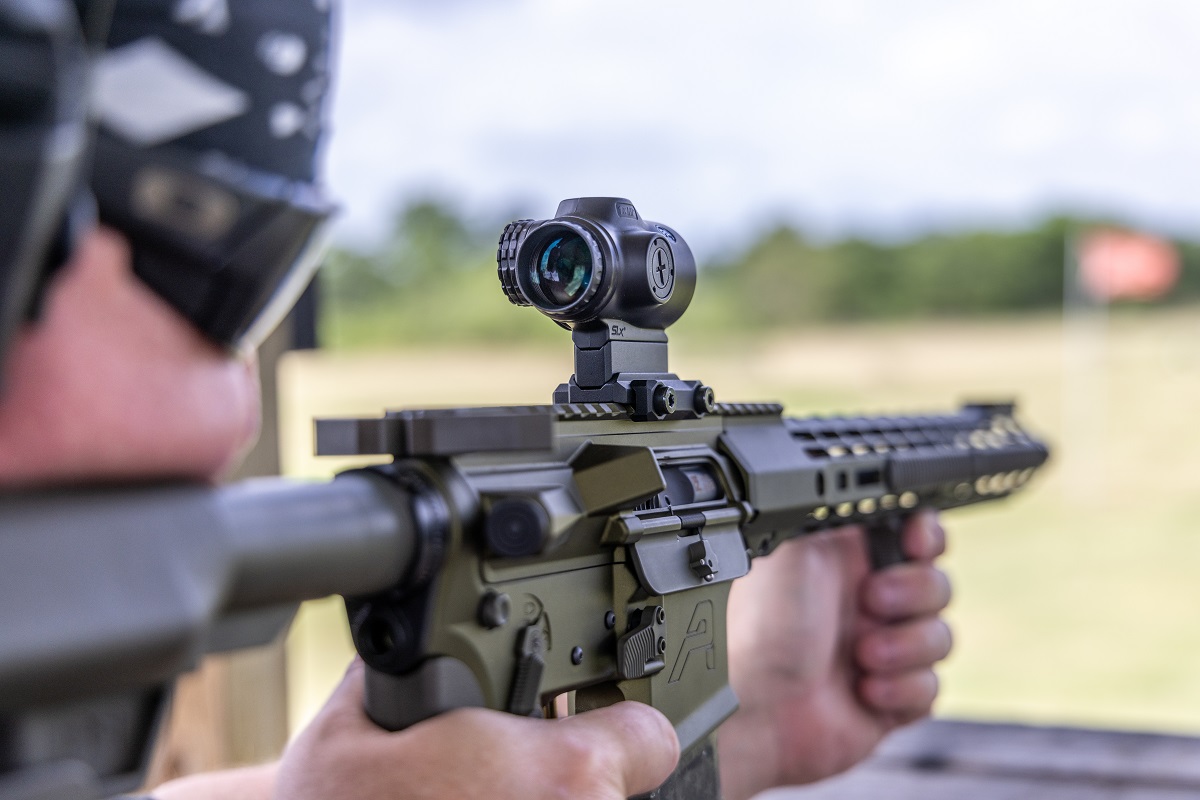Prism scopes have long been something of an underrated optic. A highly versatile option, they sit somewhere between red dots and traditional variable magnification scopes, offering a unique blend of the pros and cons of each. This makes them exceptionally well-suited to general purpose or multi-role rifles but often outclassed for dedicated short-range or long-range applications.
Despite this, prism scopes have enjoyed a long and venerated history in the armed forces, primarily in the form of Trijicon’s Advanced Combat Optical Gunsight—or as you may know it, the ACOG.
Trijicon’s ACOG line of optics is probably the most well-known form of prism scope. It’s carved out a role for itself as one of the most iconic optics of all time, having been used by the United States Army, Marine Corps, and Air Force as well as foreign military and police units.
Despite this, the number of prisms on the market is dwarfed by the amount of red dots and scopes available. With these unique optics being less common, misinformation about them abounds. Below, we’ll take a look at the facts of what a prism scope is, how it works, and when you should choose one over other optics.

What is a Prism Scope?
At its simplest, a prism scope is just a magnified optic that uses a glass prism to magnify light. Traditional scopes use a set of lenses contained within an erector tube assembly, but a prism scope simplifies the design by eliminating several components and opportunities for failure with the system.
Because the prism is a single chunk of glass, it’s considerably smaller than an erector tube assembly. The multiple lenses in traditional scopes require a certain amount of space between them to achieve the desired magnification level. This places a hard lower limit on how short the scope can be, which, in turn, limits how light it can be.
With a prism, there are no internal lenses to be spaced, only a single prism with a set magnification level. As a result, a prism scope can be half the length or less compared to a traditional scope.
Prism scopes come with a lot of other benefits as well, including reduced weight, high durability, and often a prodigious field of view, but they’re not a fit for every scenario. Tight eye boxes and limited magnification make prism scopes unsuited for several applications, most notably long-range precision shooting.

How Does a Prism Scope Work?
All scopes perform roughly the same core function; they concentrate light to create a magnified image for the user. But, how they accomplish this can vary, and that’s where prism scopes separate themselves from the pack.
Prisms themselves come in a lot of shapes and sizes, but they all do basically the same thing: bend light. In a prism scope, the prism is designed to magnify the image without distorting it. Prisms can bend light in other ways as well, including splitting it into individual colors, as is seen on one iconic album cover.
As we covered above, the prism takes the place of the erector tube assembly and internal lenses of a traditional scope. Light passes through the objective lens (the one facing the target), is concentrated into a magnified image in the prism, and is then shown through the ocular lens (the one you look through).
Of course, since this is a rifle optic and not a monocular, a reticle is required to create an effective sight picture. In a traditional rifle scope, a reticle can be added on either the ocular or objective side of the erector assembly, depending on whether a first or second focal plane is desired. These reticles can be laser etched into a glass lens, formed out of wire, or even made from fiber optics polymer.
In a modern prism scope, the reticle is usually laser etched into a glass lens that sits between the objective lens and the prism. Technically, this makes it a second focal plane reticle, but since prism scopes lack adjustable magnification, the distinction is moot.

What Are The Benefits of Using a Prism Scope?
To understand the benefits of prism scopes, it’s important to determine what we’re comparing them against. For instance, prism scopes offer an increase in accuracy and precision—if you’re comparing them to iron sights or red dots. Compared to a traditional variable zoom scope, a prism sight will often be the less precise of the two on account of its limited magnification.
Prism scopes offer a shooting experience that is much like a traditional rifle scope. The etched reticle offers a level of precision that red dots and iron sights can’t match; cross hairs can be much thinner than even the finest front sight post or red dot.
Certain designs, such as the chevron found in many of our ACSS reticles, even offer infinitely precise aiming points. As such, you can expect a prism scope to be as precise as a scope of equal magnification.
Similarly, prism scopes usually offer improved target acquisition speeds compared to scopes, but not necessarily compared to red dots or iron sights. Acquisition speed with iron sights largely comes down to the skill of the user, so it’s hard to make a direct comparison.
Red dots, with their unlimited eye relief, will almost always trump prism scopes when it comes to acquisition speed—the exception being 1x prism sights. Traditional scopes, though, will almost always lag behind. Prism scopes’ wide field of view and lack of adjustable magnification make it much easier to find and acquire a target than a traditional scope.
This brings us to our next advantage: Field of view. There’s no real point in comparing a prism scope’s field of view to a red dot, since red dots technically have an infinite field of view. Compared to almost any other magnified optic, though, prisms will generally have a superior field of view, which can be a substantial benefit for hunting or tactical applications.
Prism optics also tend to be lighter and more durable than comparable magnified optics. Again, it’s difficult to compare them to red dots or iron sights in this respect—both can be as light or as durable as desired as long as you’re willing to pay for it.
Compared to traditional rifle scopes, though, prism sights almost always win on weight. The lack of an erector assembly allows a prism sight to be smaller, and consequentially, lighter. It also creates a design with fewer moving parts, which is often easier to ruggedize. Trijicon’s ACOG scopes have a record for durability that is seldom surpassed, even by optics several times the price.
Lastly, prism scopes come with a unique advantage over red dots, although it’s not one that is applicable to every user. Prisms, like other optics with etched or wire reticles, tend to be significantly clearer for those with astigmatism. The blooming effect or distortion experienced by some users can be heavily reduced or completely eliminated by prisms, making 1x models an excellent substitute for red dots for short-range engagements.

What Are The Drawbacks of Using a Prism Scope?
While prism scopes do come with a wealth of advantages, they’re not without their limitations. The biggest of these is their limited magnification.
Because prism scopes use a solid glass prism rather than moveable lenses, their magnification level is fixed, as we discussed previously. This is a limitation all in itself, forcing the user to choose a single magnification at which to use their firearm at all times or mount a secondary optic without magnification if they want a second option. But, even a prism scope and red dot combination can’t match the versatility of an adjustable scope.
Additionally, because the magnification power of a prism is proportionate to its size, there is an upper limit on how powerful a prism scope can be before it becomes unwieldy. Trijicon’s largest prism scope offers only 6x magnification, while our largest Primary Arms prism comes in at 5x. A prism scope with a magnification level significantly higher than this would be so large and heavy as to offer no real benefit over a traditional scope. However, as the technology develops, prism scopes are slowly becoming smaller and lighter, as can be seen with our series of MicroPrisms. This leaves open the possibility that higher-powered prism scopes could become feasible in the future.
As a result, prism scopes are a poor choice for rifles that are intended solely for use at extended ranges. Traditional scopes can offer magnification of 36x or more, making them a clear choice for these applications.
Prism optics also frequently, but not universally, suffer from short eye relief and tight eye boxes. Many prism optics, even at low 3x or 4x powers, have highly restrictive eye boxes that can make it difficult to engage targets on the move or from unconventional positions.
A tight eye-box can also be an issue in extremely short-range engagements. At 15 yards or less, the limited eye relief of a prism scope can make them slower than red dots, although certain aiming techniques can close the gap significantly.
Certain modern prism optics, such as our SLx 1x MicroPrism ™, defy this stereotype, though.

1x Prism Optics
Unmagnified 1x prism optics are the exception to almost all the usual rules that apply to prism optics. Unlike their medium-power counterparts, 1x prisms can be as small and lightweight as red dots and serve in many of the same roles.
Our SLx 1x MicroPrism, for example, offers a usable eye relief range of 2″-6″ and a remarkably forgiving eye box, making it a fast, capable option for those who prefer the precision of an etched reticle but still want the speed of a red dot.
It’s astigmatism-friendly, but still every bit as fast as a red dot for most uses. You won’t be able to mount it to the handguard of an AK the way you can a red dot, but the eye relief is so generous that it can even be used with a magnifier for maximum versatility.
Since the MicroPrism uses an etched rather than a projected reticle, it’s also able to support more complicated reticle designs. In addition to a chevron aiming point and horseshoe, the MicroPrism also offers an auto-ranging tool—something red dots simply can’t do. It’s even available with a 9mm-specific reticle with drop compensation.
The illumination in the MicroPrism is incredibly efficient, offering a massive 29,000 hours of battery life on a medium setting. Unlike a red dot, though, even if the battery dies, your sight will still be usable, albeit with a black reticle.
k

Who Should Use a Prism Scope?
Prisms thrive as a jack-of-all-trades optic, making them perfect for a do-all carbine. While they struggle at truly long ranges and are sometimes outclassed by red dots at CQB distances, they dominate the medium-range space, which is where most rifles tend to get used.
The low weight and compact size of prism scopes make them fantastic options for rifles that get carried a lot, whether through the woods on a hunt or through the streets on patrol. With proper training, even a 3x or 4x prism can be used effectively at short range and offers sufficient magnification for accurate shots on common targets out to 400 yards or more.
Given their popularity with the armed forces, it’s obvious that prism scopes serve well in tactical roles, but they can also be highly effective on lightweight hunting rifles, or any carbine with a wide range of intended uses.
Prism scopes serve as an excellent option for both beginner and expert marksmen alike. New enthusiasts will appreciate the simplicity of aiming compared to iron sights and the greater precision over a red dot, while seasoned users will be able to utilize the scope to its full potential across all ranges.

Conclusion
Prism scopes utilize a simplified design, replacing multiple internal components of a traditional scope with a single rugged prism. Their wide field of view, low weight, and staggering versatility make them an excellent option for a wide range of applications, although highly specialized rifles are often better served with equally specialized optics.
If you’re still having trouble deciding on an optic, we recommend checking out our series of optic comparisons, including articles on the merits of low-power variable optics versus prism scopes, the difference between holographic sights and traditional red dots, and a comparison of the benefits of red dot and magnifier combos against LPVOs.



